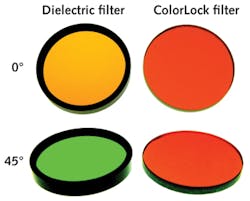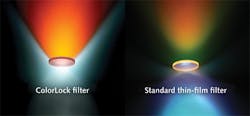Optical Filters: Filter stacks transmit wide-angle incident light without shifting wavelength

JASON KECK
Wide-angle imaging systems have to overcome numerous problems. Distortion of the shape of objects in the scene is the predominant issue, recognizable as the "fish-eye lens" look that is often corrected in software. However, lens distortion is not the only problem.
Iridescence, or the change in transmitted or reflected color of light viewed from different angles, is a phenomenon that can be found both in nature and in artificial light-detecting systems with precise color requirements, where it can cause many problems.
Wide-angle color-sensing applications commonly require that a wavelength must be detectable regardless of the incident angle. Iridescence through a thin-film-coated optical element can cause problems in this situation by distorting the spectral transmission of light coming from peripheral objects.
Maximizing light transmission in a thin-film coating's passband while blocking out-of-band light is a requirement for coated optical components such as dielectric filters; however, the wavelength's transition commonly only remains steady within relatively narrow cone angles. Beyond angles of 5°, such filters are susceptible to iridescence, observable as a change of color, or "blueshift." As the angle of light entering the filter increases, the light propagates through more of each thin-film stack layer, altering the apparent overall thickness of the optical-filter stack and affecting the performance of the original intended design. This can make such filters unsuitable for wide-angle imaging applications with bright illumination and where higher standards of consistency are required of the wavelength of all incident light.
One of the more convoluted wide-angle imaging solutions is the use of a cluster of cameras or a polycamera, pointing in various directions like the compound eye of an insect; the resulting multiple pictures are then assembled into one image in software. Although the light entering each camera thus fills only a narrow cone angle, the complexity and resultant high expense of such a system is obvious.
Engineers at Reynard have addressed this problem in a single optical device with a system in which two or more layers of filter glass are combined into a stacked configuration. These ColorLock filter stacks eliminate the wavelength shift as incident angle increases and are customized to meet specific system needs (see Fig. 1).
Software is used to determine the exact composition and thickness of the layers in these filters; the software determines a merit function that best estimates the filter requirements and allows filter stacks to be designed for band pass, short-wave pass, long-wave pass, or user-specified functions. Incident angles can be as high as 50° without any shift in the transmitted wavelength, while more traditional coated filters with the same conditions would see a significant shift toward shorter wavelengths.
Wide-angle filter stack apps
There is a multitude of applications for this type of filter. In the field of digital imaging, colorimeters-which take wideband spectral energy readings-are used to profile and calibrate display devices, verifying that pixel color and intensity at the edge of a display matches the performance of pixels in the center of the display.
In astronomy, biomedical or fluorescence imaging, and mineralogy, hyperspectral imaging has many important applications. It is essential that the incident light undergo as little iridescence as possible. Also, when precision imaging instruments are expensively launched into orbit, the filters must be robust enough to withstand extreme environmental operating conditions.
In agriculture, the color of crops or food products reveals vital information. The use of Earth-observing satellites to measure the "vegetation index" of crops (a measurement of green hue) is nothing new, but the affordability of aerial drones has brought new possibilities. A drone can be programmed with GPS data to fly on a fixed pattern over a designated crop area and take wide-angle images at regular intervals, building up a picture of the vegetation index of crops. If the images used in such applications provide accurate spectral data that is as free as possible from iridescent distortion, it can give farmers precise control over fertilizer application rates and greatly improve efficiency and productivity. This is a considerable cost saving over low-resolution, narrowband satellite imagery and conventional aerial photography using manned aircraft.
Design hurdles
There are three complicating factors in the design of such filter stacks. The first is the limited choice in filter glass, limited not only by manufacturer availability but also by physics. Filter glass with an ideal edge cut-on or cut-off wavelength for an application is not always easy to find, or may be impossible to precisely manufacture. Where it is available, the designer is then limited by what the manufacturer can deliver in a reasonable time, as melts may be scheduled as infrequently as once every several years, depending on demand.
The second factor is that, while the perfect filter glass for a particular application may not exist, there are hundreds of other glass types from numerous vendors that can be combined to achieve a close approximation of the requirement.
The third complicating factor is that the design of ColorLock filters is a massively multidimensional, nonsmooth optimization challenge. Physical manufacturing requirements restrict the thickness of all combined individual layers to not exceed the overall thickness requirement of the resulting optical component, further putting restrictions on the selection of specific filter glass types.
Reynard streamlined this complex design process by developing in-house software into which all of the system requirements are fed. The software produces a manufacturable design for a filter in which the necessary materials are combined at the correct thickness in each layer. The design is then manufactured and validated for performance.
Rugged, no coating degradation
Advantages of using a filter stack rather than a thin-film-coated optical element include wide-angle performance (see Fig. 2) and high durability. Because the glass itself performs the blocking, there is no concern of coating degradation due to extreme environmental shifts, contamination, or mishandling. Filter stacks are as durable as the glass they are made from, surviving aggressive cleaning methods, severe abrasion, salt/fog testing, humidity, and temperature cycling per durability standards of MIL-PRF-13830B, MIL-C-48497A, and MIL-C-675C.Because all filter glass types have approximately the same index of refraction, there is no Fresnel loss as light propagates from one internal layer to another. However, as with any glass, the air-to-substrate interfaces will incur an ~8% total Fresnel loss for the component.
The addition of a broadband antireflection (BBAR) coating on each air-to-substrate surface can mostly eliminate this loss. The spectral range of the BBAR is designed to be much wider than the active spectral region of the filter, so the stability of the transmission band will not be affected by changes in the angle of the filter. Blocking coatings can also be added if it is necessary to create steeper edges for in-band performance; however, doing so can affect the wide-angle performance at the edge wavelengths.
ColorLock filter stacks can be designed for spectral ranges from ultraviolet to near-infrared, with transmission exceeding 60% at the specified design wavelength. This transmission may not be as high as with dielectric filters, but is sufficient for applications with controlled and stable illumination, such as for machine vision, in which the consistency of wavelengths from wider incident angles is more important than transmission.
Having overcome considerable design challenges, we believe that these filter stacks can be used as an innovative solution in applications that demand consistent wavelengths from incident angles that are wide enough that dielectric filters would not be sufficient, and where the higher transmission that is afforded by dielectric filters is less important.
Jason Keck is director of technology at Reynard, San Clemente, CA; email: [email protected]; www.reynardcorp.com.
